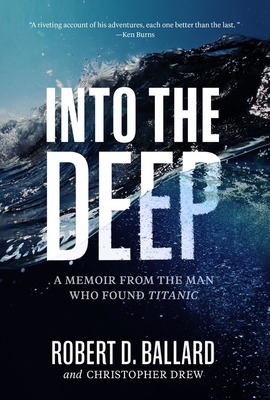

 National Geographic Society
National Geographic Society
Into the Deep: A Memoir from the Man Who Found Titanic


Key Metrics
- Robert D Ballard
- National Geographic Society
- Hardcover
- 9781426220999
- -
- -
- Biography & Autobiography > Science & Technology
- English
 Secure Transaction
Secure TransactionBook Description
Best known for finding the doomed ship Titanic, celebrated adventurer Robert Ballard has a lifetime of stories about exploring the ocean depths. Now he gets personal, telling the stories behind his most exciting discoveries--including how a top-secret naval mission provided the opportunity for his Titanic discovery--and opens up about his private tragedies.
He frankly recounts the struggles he has worked through, rising to prominence as a scientist whose celebrity drew academic scorn. And he reveals the triumph and agony in the years after his Titanic find: While media around the world clamored for interviews, he grappled with the death of his 20-year-old son and the collapse of his marriage amid academic and military career demands. Finally, he addresses his late-in-life discovery of his own dyslexia, which he now sees as a gift that has shaped his life and accomplishments.
Twice a New York Times best-selling author, here Ballard partners with investigative reporter and bestselling author Christopher Drew to tell the dramatic and often surprising stories behind his newsworthy discoveries. Timed to appear as the National Geographic Channel airs a special documentary about Ballard''s explorations, Into the Deep will intrigue adventure lovers young and old.
Brilliant, insightful, and surprising, Into the Deep is the definitive story of the dangers and discoveries, conflicts and triumphs that have shaped the remarkable life of an American hero.
Author Bio
The Center for Ocean Exploration (COE) works in collaboration with the Ocean Exploration Trust (OET), which Dr. Ballard founded in 2009. OET owns and operates the E/V NAUTILUS one of two of America’s ships of exploration funded by NOAA’s Office of Ocean Exploration and Research. A major component of this joint effort is using high bandwidth satellite links to connect ships at sea with a telecommunications hub at GSO called the Inner Space Center (ISC). ISC serves a dual role for COE. The first is to make it possible for scientists ashore to participate via “tele-presence” in real time exploration as it happens. The second is to support a variety education outreach effort.
A native of Kansas, Ballard received his undergraduate from the University of California, Santa Barbara in Geology and Chemistry and his doctorate from GSO in 1975 before spending 30 years at Woods Hole Oceanographic Institution. There he helped develop deep submersibles and remotely operated vehicle systems, after which he returned to his alma mater and generated even more interest in GSO among a public that is fascinated by the mysteries of the deep.
Ballard came to instant public fame in 1985, of course, as the discoverer of the final resting place of the ill-fated R.M.S Titanic, followed by the German Battleship BISMARCK and numerous ancient shipwrecks. Having said that Dr. Ballard prefers to be known for the discovery of the first hydrothermal vents and their exotic chemosynthetic animal communities in the Galapagos Rift in1977 followed in 1979 with the discovery of high temperature “Black Smokers” on the East Pacific Rise in 1979.
Research Interests
In broad terms, Dr. Ballard’s research focuses on ocean exploration. This can involve searching for ancient or modern shipwrecks, using ROVs to describe submarine hazards such as under-sea volcanoes or possible earthquake centers, discovering new areas of biological activity, or characterizing large swaths of the seafloor using research vessels equipped with side-scan sonar and multi-beam echo-sounders. He is probably best known for locating the wreck of the Titanic in 1985.
He now directs the Institute for Archeological Oceanography, which he started in 2003. The institute combines the disciplines of oceanography, ocean engineering, maritime history, anthropology and archeology into one academic program. One emphasis of the program is research in the Black Sea and eastern Mediterranean. Graduate students started entering the program in 2004 and completion requires 92 credits, more than any other doctorate program at URI. Graduates emerge with two degrees—a master’s in archeology and a doctorate in oceanography. The institute involves a broad cross section of URI faculty plus faculty from other institutions such as Harvard University, the University of Pennsylvania, Florida State University, MIT and Woods Hole. Dr. Ballard has a team of support experts in several disciplines at GSO that assist him in the worldwide explorations. He has published 18 books, many scientific papers and articles for National Geographic magazine. He was the recipient of the 2003 National Humanities Medal by President George W. Bush and received the National Geographic Society’s coveted Hubbard Medal in 1996 for his oceanographic accomplishments.
Dr. Ballard also directs the Center for Ocean Exploration, which includes the Inner Space Center (ISC) and management of the research vessels EV Nautilus and the NOAA ship Okeanos Explorer. Dr. Ballard was the innovator behind the ISCs telepresence technology, which provides video and audio links from live ship-board explorations to persons (students, educators, scientists) on land for interactive experiences in oceanographic research.
Education
Ph.D., Geological Oceanography University of Rhode Island 1974
B.S., Physical Sciences University of California, Santa Barbara 1965
Source: The University of Rhode Island
Videos




Community reviews
Write a ReviewNo Community reviews